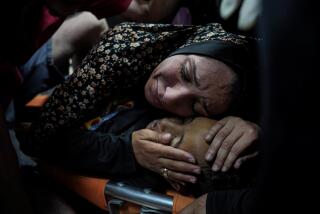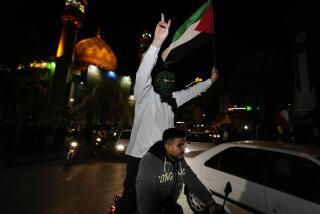Iran Invaders Appear Trapped by Iraqi Forces
- Share via
BAGHDAD, Iraq — Iraqi troops appear to have surrounded and trapped the main body of an Iranian invasion force in southeastern Iraq but are encountering difficulties and sustaining heavy casualties in flushing them out, Western diplomats and military experts said Monday.
“The invading force is now entrapped in a killing zone,” Iraq’s defense minister, Gen. Adnan Khairallah, told the official Iraqi News Agency. He melodramatically called upon the Iranians to surrender or face death “by cremation” on the small island, about three miles inside Iraqi territory, where the bulk of their troops appear to be bottled up.
Iranian Cities Bombed
Iraqi jet fighters, meanwhile, bombed several Iranian cities for the third straight day and also several Iranian oil-pumping stations, causing “devastating hits,” an Iraqi military communique said.
Iran’s official Tehran radio said the elite Iraqi Presidential Guard has been thrown into the bloody conflict near Basra after the 3rd Army Corps, defending Iraqi lines, had been badly mauled. Front-line correspondents reported the battlefield strewn with Iraqi corpses, the broadcast added.
The Iraqi port of Basra, only six miles west of the current fighting, again came under heavy Iranian artillery fire, which killed 12 more people and injured 53, raising the cumulative toll from four days of shelling there to 70 killed and 335 wounded.
Here in the Iraqi capital, residents reported that two Iranian surface-to-surface missiles struck within a 24-hour period. The latest blast came shortly after midnight and sent a dense cloud of smoke over much of the city of 4.5 million.
In Washington, State and Defense department officials said Iran’s latest military thrust appeared to be a limited operation despite thousands of casualties claimed by both sides, Reuters news service reported.
The officials said they could not provide an accurate death toll but that the fighting that has followed Iran’s thrust toward Basra appeared to be very bloody.
One private analyst said that Iran has apparently committed up to 90,000 troops in its latest effort against Basra but that the figure is short of what is needed, given Iraq’s superiority in artillery and air power.
“The Iranians are dying by the bushel, but unless a lot more troops and equipment are used by Iran, our assessment of a standoff in the war has not changed,” said a Pentagon official, who asked not to be identified.
Iraqi war communiques indicated that heavy fighting was continuing east of an area known as Fish Lake, where the Iranians established a foothold at the start of their latest offensive Thursday night.
Confined to Small Island
Diplomats and military experts said they thought most of the Iranian force was now confined to an island, three miles long by one mile wide, on the southwestern edge of the Shaab Muhaygin, a large marshy area flooded by Iraqi defense planners a few years ago to create a water barrier extending east to the border. The island is fronted on its west bank by the artificial Fish Lake and by the marshes to the north, east and south.
The Iranians overran the island and gained positions north and south of the marshes at the start of their offensive. They also slipped around the southeastern end of Fish Lake to gain several footholds on the west bank, only six miles east of Basra, Iraq’s second-largest city.
“From what we understand, the Iraqis have now cleared the west bank of Fish Lake and the area south of the water barrier, but there is still fighting on the island and on the northern bank of the barrier,” one foreign military expert here said.
This expert and other diplomats said they believe it is only a matter of time before the Iranians are beaten back completely. “They are taking an enormous hammering by Iraqi artillery,” one diplomat said.
A Significant Feat
Although crossing the water barrier was a significant feat that seemed to take the Iraqis by surprise, the experts said they consider it unlikely that the Iranians will be able to drive through the still-formidable Iraqi defenses to reach Basra.
“We don’t think they have the armor, ammunition or logistical ability to achieve that kind of breakthrough on such a heavily defended front,” one Western military expert said.
Nevertheless, routing the Iranians from their entrenched positions around the lake has proven far tougher and costlier to the Iraqis than at first imagined, several diplomats said.
Although rival war communiques claiming that each side has inflicted tens of thousands of casualties on the other are doubtless exaggerated, there is ample evidence to suggest that, for both sides, this has been the costliest battle of the war since last February’s fighting for the Faw Peninsula, the diplomats added.
One reason for this may be the fact that the same water barrier the Iraqis created to keep the Iranians out now seems to be preventing the Baghdad forces from making full use of their armor, military analysts said.
A foreign doctor in Basra told his embassy in Baghdad by telephone that he saw the bodies of about 1,000 Iraqis being brought Sunday to the hospital where he works. Wounded were also reportedly being moved up to Baghdad, 300 miles northwest of Basra, by train, foreign witnesses said.
Civilians Leaving Basra
The witnesses, who did not want to be identified by name, added that civilians--mostly women and children and foreign construction workers in Basra--are leaving the city in large groups because of the heavy, indiscriminate shelling.
The Iraqi News Agency quoted Defense Minister Khairallah as saying that the Iranians were trapped by Iraq’s 3rd and 7th Army Corps. This appeared to be significant, because until now there had been no mention by Iraq of the involvement of the 7th Corps in the fighting. Diplomats said this could mean either that the battle had expanded over the past day or two or that 7th Corps units were moving northwest to form a vise around the remaining Iranians.
More to Read
Sign up for Essential California
The most important California stories and recommendations in your inbox every morning.
You may occasionally receive promotional content from the Los Angeles Times.










